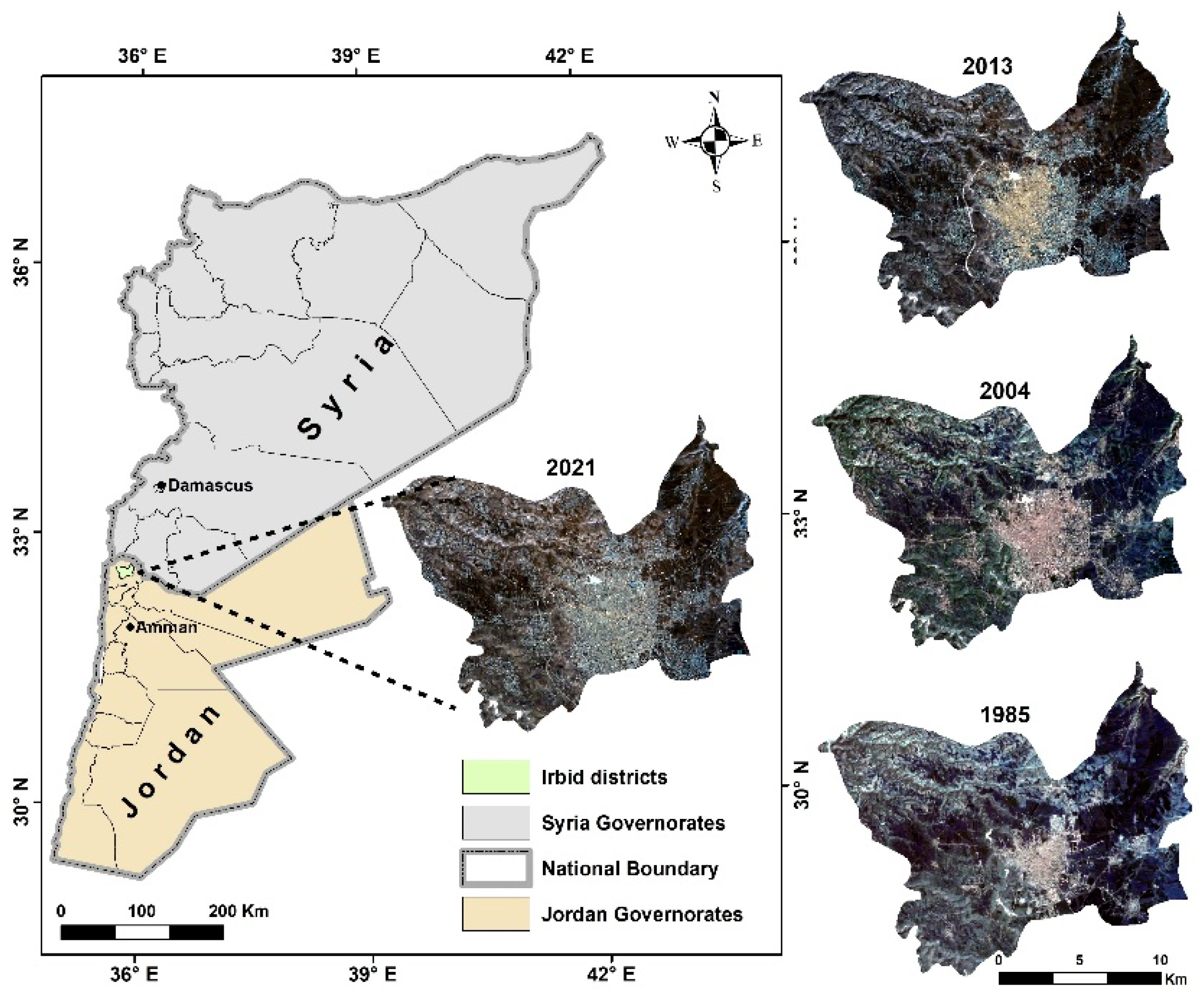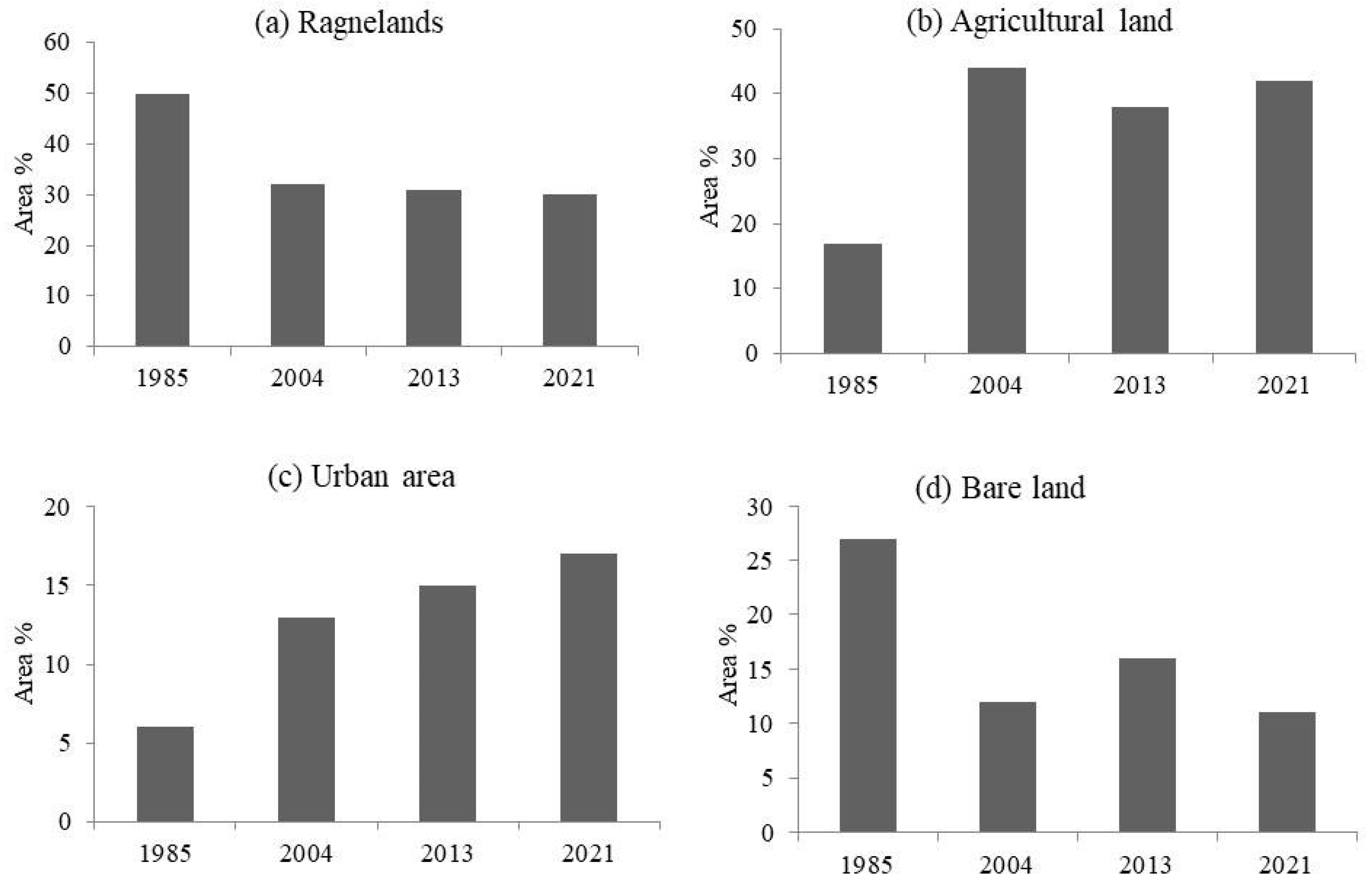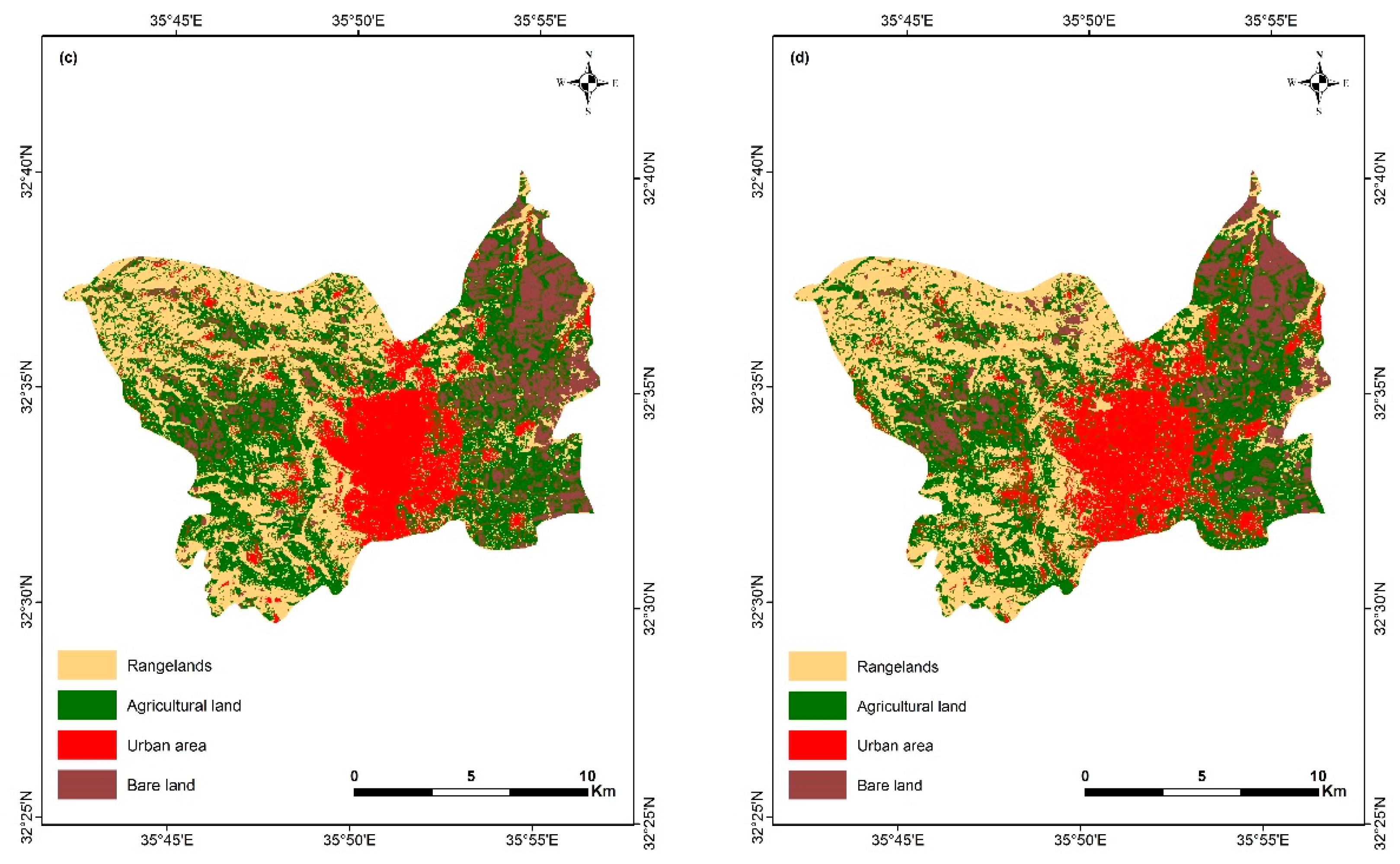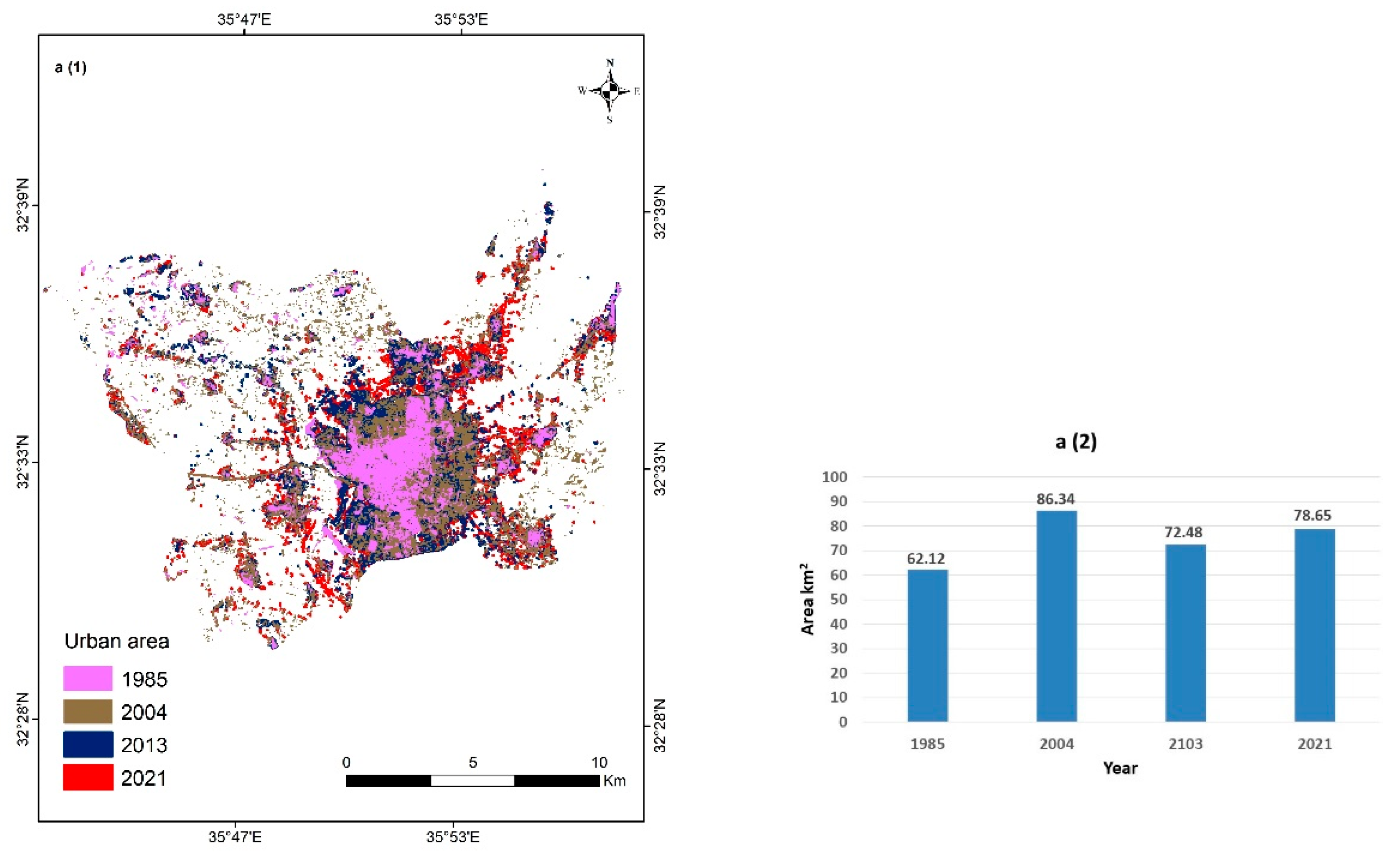Evaluating the Impact of the Influx of Syrian Refugees on Land Use/Land Cover Change in Irbid District, Northwestern Jordan
Abstract
:1. Introduction
2. Materials and Methods
2.1. Study Area
2.2. Datasets
2.3. Data Processing and Classification
3. Results
3.1. Classification Accuracy Assessment
3.2. Land Use/Land Cover Change Patterns (1985–2021)
4. Discussion
5. Recommendation
Author Contributions
Funding
Institutional Review Board Statement
Informed Consent Statement
Data Availability Statement
Acknowledgments
Conflicts of Interest
References
- Gbanie, S.P.; Griffin, A.L.; Thornton, A. Impacts on the urban environment: Land cover change trajectories and landscape fragmentation in post-war Western Area, Sierra Leone. Remote Sens. 2018, 10, 129. [Google Scholar] [CrossRef] [Green Version]
- Pavanello, S.; Elhawary, S.; Pantuliano, S. Hidden and Exposed: Urban Refugees in Nairobi, Kenya; Overseas Development Institute: UK, London, 2010. [Google Scholar]
- Walker, R.B.; Hiller, J.E. Places and health: A qualitative study to explore how older women living alone perceive the social and physical dimensions of their neighbourhoods. Soc. Sci. Med. 2007, 65, 1154–1165. [Google Scholar] [CrossRef] [PubMed]
- UNHCR. Syria Regional Refugee Response (Jordan); The UN Refugee Agency: Geneva, Switzerland, 2020. [Google Scholar]
- Department of Statistics. The Hashemite Kingdom of Jordan; Ministry of Planning: Amman, Jordan, 1994.
- Department of Statistics. The Hashemite Kingdom of Jordan; Ministry of Planning: Amman, Jordan, 2015.
- Department of Statistics. The Hashemite Kingdom of Jordan; Ministry of Planning: Amman, Jordan, 2020.
- UNHCR. Syrian Regional Refugee Response Jordan; The UN Refugee Agency: Geneva, Switzerland, 2018.
- MOPIC. Jordan Response Plan for the Syria Crisis (JPR); Ministry of Planning and International Cooperation: Amman, Jordan, 2018.
- Mas, J.-F.; Velázquez, A.; Díaz-Gallegos, J.R.; Mayorga-Saucedo, R.; Alcántara, C.; Bocco, G.; Castro, R.; Fernández, T.; Pérez-Vega, A. Assessing land use/cover changes: A nationwide multidate spatial database for Mexico. Int. J. Appl. Earth Obs. Geoinf. 2004, 5, 249–261. [Google Scholar] [CrossRef]
- Olson, J.M.; Alagarswamy, G.; Andresen, J.A.; Campbell, D.J.; Davis, A.Y.; Ge, J.; Huebner, M.; Lofgren, B.M.; Lusch, D.P.; Moore, N.J. Integrating diverse methods to understand climate–land interactions in East Africa. Geoforum 2008, 39, 898–911. [Google Scholar] [CrossRef]
- Yuan, F.; Sawaya, K.E.; Loeffelholz, B.C.; Bauer, M.E. Land cover classification and change analysis of the Twin Cities (Minnesota) Metropolitan Area by multitemporal Landsat remote sensing. Remote Sens. Environ. 2005, 98, 317–328. [Google Scholar] [CrossRef]
- Serra, P.; Pons, X.; Saurí, D. Land-cover and land-use change in a Mediterranean landscape: A spatial analysis of driving forces integrating biophysical and human factors. Appl. Geogr. 2008, 28, 189–209. [Google Scholar] [CrossRef]
- Rahimi, A. A methodological approach to urban land-use change modeling using infill development pattern—A case study in Tabriz, Iran. Ecol. Process. 2016, 5, 1. [Google Scholar] [CrossRef] [Green Version]
- Sahwan, W.; Lucke, B.; Kappas, M.; Bäumler, R. Assessing the spatial variability of soil surface colors in northern Jordan using satellite data from Landsat-8 and Sentinel-2. Eur. J. Remote Sens. 2018, 51, 850–862. [Google Scholar] [CrossRef] [Green Version]
- Wulder, M.A.; White, J.C.; Goward, S.N.; Masek, J.G.; Irons, J.R.; Herold, M.; Cohen, W.B.; Loveland, T.R.; Woodcock, C.E. Landsat continuity: Issues and opportunities for land cover monitoring. Remote Sens. Environ. 2008, 112, 955–969. [Google Scholar] [CrossRef]
- Roy, D.P.; Wulder, M.A.; Loveland, T.R.; Woodcock, C.E.; Allen, R.G.; Anderson, M.C.; Helder, D.; Irons, J.R.; Johnson, D.M.; Kennedy, R. Landsat-8: Science and product vision for terrestrial global change research. Remote Sens. Environ. 2014, 145, 154–172. [Google Scholar] [CrossRef] [Green Version]
- Gorelick, N.; Hancher, M.; Dixon, M.; Ilyushchenko, S.; Thau, D.; Moore, R. Google Earth Engine: Planetary-scale geospatial analysis for everyone. Remote Sens. Environ. 2017, 202, 18–27. [Google Scholar] [CrossRef]
- Tamiminia, H.; Salehi, B.; Mahdianpari, M.; Quackenbush, L.; Adeli, S.; Brisco, B. Google Earth Engine for geo-big data applications: A meta-analysis and systematic review. ISPRS J. Photogramm. Remote Sens. 2020, 164, 152–170. [Google Scholar] [CrossRef]
- UNHCR. Field Trip Reports; Hosseini, K., Ed.; The UN Refugee Agency: Geneva, Switzerland, 2015. [Google Scholar]
- UNHCR. Registered Persons of Concern Refugees and Asylum Seekers in Jordan; The UN Refugee Agency: Geneva, Switzerland, 2021. [Google Scholar]
- Carrion, D. Syrian Refugees in Jordan: Confronting Difficult Truths; Chatham House, The Royal Institute of International Affairs: London, UK, 2015. [Google Scholar]
- Müller, M.F.; Yoon, J.; Gorelick, S.M.; Avisse, N.; Tilmant, A. Impact of the Syrian refugee crisis on land use and transboundary freshwater resources. Proc. Natl. Acad. Sci. USA 2016, 113, 14932–14937. [Google Scholar] [CrossRef] [Green Version]
- Alshoubaki, W.; Harris, M. The impact of Syrian refugees on Jordan: A framework for analysis. J. Int. Stud. 2018, 11, 154–179. [Google Scholar] [CrossRef] [PubMed]
- Hagenlocher, M.; Lang, S.; Tiede, D. Integrated assessment of the environmental impact of an IDP camp in Sudan based on very high resolution multi-temporal satellite imagery. Remote Sens. Environ. 2012, 126, 27–38. [Google Scholar] [CrossRef]
- Sahwan, W.; Lucke, B.; Sprafke, T.; Vanselow, K.A.; Bäumler, R. Relationships between spectral features, iron oxides and colours of surface soils in northern Jordan. Eur. J. Soil Sci. 2020, 72, 80–97. [Google Scholar] [CrossRef]
- Meteorological Department. The Hashemite Kingdom of Jordan; Ministry of Transportation: Amman, Jordan, 2021.
- Jensen, J.R. Introductory Digital Image Processing: A Remote Sensing Perspective, 2nd ed.; Jensen, J.R., Ed.; Prentice Hall Series in Geographic Information Science; Prentice Hall: London, UK; Prentice-Hall International: Upper Saddle River, NJ, USA, 1996. [Google Scholar]
- Google Earth Engine. 2012. Available online: https://earthengine.google.org/#intro (accessed on 5 February 2014).
- Anderson, J.R.; Hardy, E.E.; Roach, J.T.; Witmer, R.E. Professional Paper; US Geological Survey: Reston, VA, USA, 1976.
- Jensen, J.R. Introductory Digital Image Processing. A Remote Sensing Perspective; Pearson Series in Geographic Information Science; Pearson Education Inc.: Glenview, IL, USA, 2016. [Google Scholar]
- Manandhar, R.; Odeh, I.O.A.; Ancev, T. Improving the accuracy of land use and land cover classification of Landsat data using post-classification enhancement. Remote Sens. 2009, 1, 330–344. [Google Scholar] [CrossRef] [Green Version]
- Monserud, R.A.; Leemans, R. Comparing global vegetation maps with the Kappa statistic. Ecol. Model. 1992, 62, 275–293. [Google Scholar] [CrossRef]
- Phiri, D.; Morgenroth, J. Developments in Landsat Land Cover Classification Methods: A Review. Remote Sens. 2017, 9, 967. [Google Scholar] [CrossRef] [Green Version]
- Hugo, G. Migration, Development and Environment; International Organization for Migration: Geneva, Switzerland, 2008. [Google Scholar]
- Hugo, G. Environmental Concerns and International Migration. Int. Migr. Rev. 1996, 30, 105–131. [Google Scholar] [CrossRef]
- Refugees, Displaced Persons, and Forced Migration Studies Center (RDPFMSC). Successive Waves of Asylum and Immigration to the Hashemite Kingdom of Jordan and Their Effects during 100 Years Report; Yarmouk University: Irbid, Jordan, 2021. [Google Scholar]
- Department of Statistics. The Hashemite Kingdom of Jordan; Ministry of Planning: Amman, Jordan, 2004.
- Department of Statistics. The Hashemite Kingdom of Jordan; Ministry of Planning: Amman, Jordan, 2021.
- United Nations. International Migration Report; United Nations: New York, NY, USA, 2017. [Google Scholar]
- Rosshandler, K. Syrian Refugee Return: Implications for the Jordanian Host State; WANA Institute, UK Aid; MercyCorps: Amman, Jordan, 2019; p. 23. [Google Scholar]
- Mercy Corps. Mapping of Host Community-Refugee Tensions in Mafraq and Ramtha, Jordan. 2013. Available online: https://data2.unhcr.org/en/documents/details/38301 (accessed on 5 February 2014).
- Wilson, C. Spectral analysis of civil conflict-induced forced migration on land-use/land-cover change: The case of a primate and lower-ranked cities in Sierra Leone. Int. J. Remote Sens. 2014, 35, 1094–1125. [Google Scholar] [CrossRef]
- UNHCR. Regional Strategic Overview 3RP, Regional Refugee & Resilience Plan 2018–2019; The UN Refugee Agency: Geneva, Switzerland, 2019. [Google Scholar]
- Li, M.; Mao, L.; Zhou, C.; Vogelmann, J.E.; Zhu, Z. Comparing forest fragmentation and its drivers in China and the USA with Globcover v2.2. J. Environ. Manag. 2010, 91, 2572–2580. [Google Scholar] [CrossRef] [PubMed]
- Reddy, C.S.; Sreelekshmi, S.; Jha, C.S.; Dadhwal, V.K. National assessment of forest fragmentation in India: Landscape indices as measures of the effects of fragmentation and forest cover change. Ecol. Eng. 2013, 60, 453–464. [Google Scholar] [CrossRef]
- Braimoh, A.K. Agricultural land-use change during economic reforms in Ghana. Land Use Policy 2009, 26, 763–771. [Google Scholar] [CrossRef]
- Griscom, H.R.; Miller, S.N.; Gyedu-Ababio, T.; Sivanpillai, R. Mapping land cover change of the Luvuvhu catchment, South Africa for environmental modelling. GeoJournal 2010, 75, 163–173. [Google Scholar] [CrossRef]
- Gorsevski, V.; Kasischke, E.; Dempewolf, J.; Loboda, T.; Grossmann, F. Analysis of the Impacts of armed conflict on the Eastern Afromontane forest region on the South Sudan—Uganda border using multitemporal Landsat imagery. Remote Sens. Environ. 2012, 118, 10–20. [Google Scholar] [CrossRef]
- Mansaray, L.R.; Huang, J.; Kamara, A.A. Mapping deforestation and urban expansion in Freetown, Sierra Leone, from pre-to post-war economic recovery. Environ. Monit. Assess. 2016, 188, 1–16. [Google Scholar] [CrossRef]
- Ministry of Interior. The Hashemite Kingdom of Jordan; Ministry of Interior: Amman, Jordan, 2015.
- Ministry of Planning and International Cooperation. Irbid Governorate Development Program 2013–2016; Ministry of Planning and International Cooperation: Amman, Jordan, 2016.







| Month | January | February | March | April | May | June | July | August | September | October | November | December | Year |
|---|---|---|---|---|---|---|---|---|---|---|---|---|---|
| Avg. high | 13.4 | 14.3 | 17.7 | 22.8 | 27.2 | 30 | 31.5 | 31.8 | 30.1 | 26.7 | 20.7 | 15.5 | 23.5 |
| Daily mean | 9.35 | 10 | 12.8 | 17.9 | 21.5 | 24 | 25.8 | 26.2 | 24.6 | 21.3 | 15.6 | 11.1 | 18.3 |
| Avg. low | 5.3 | 5.7 | 8.0 | 11.3 | 14.9 | 17.9 | 20.1 | 20.5 | 19.0 | 15.8 | 10.5 | 6.7 | 13.0 |
| Avg. Rainfall | 101 | 110 | 69.6 | 20 | 6.4 | 1.6 | 0.0 | 0.0 | 0.7 | 13.9 | 58.4 | 81.9 | 465 |
| Avg. Rainfall/day | 11.3 | 10.6 | 9.4 | 4.6 | 2.0 | 0.2 | 0.0 | 0.0 | 0.2 | 3.2 | 6.0 | 9.6 | 57.1 |
| LULC Type | General Description |
|---|---|
| Agriculture | Cropland and pasture, orchards, groves, vineyards, nurseries, and ornamental horticulture areas, confined feeding operations, other agricultural land, and mixed forest |
| Urban area | Residential area, commercial and services, industrial, transportation, communications, and utilities, industrial and commercial complexes, mixed urban or built-up, and other urban or built-up land |
| Bare land | Bare exposed rock, strip mines, quarries, transitional areas, and mixed barren land |
| Range Land | Herbaceous rangeland, shrub rangeland, and mixed rangeland |
| Year of Classified Data | Type of LULC | Rangelands | Agricultural Land | Urban Area | Bare Land | Producer’s Accuracy | User’s Accuracy | Overall Accuracy % | Kappa Value % |
|---|---|---|---|---|---|---|---|---|---|
| 1985 Classified data | Rangelands | 29 | 0 | 1 | 1 | 93.55 | 93.55 | ||
| Agricultural land | 1 | 34 | 0 | 0 | 100.00 | 97.14 | |||
| Urban area | 1 | 0 | 28 | 0 | 96.55 | 96.55 | |||
| Bare land | 0 | 0 | 0 | 40 | 97.56 | 100.00 | |||
| 97 | 96 | ||||||||
| 2004 Classified data | Rangelands | 29 | 1 | 2 | 0 | 85.29 | 90.63 | ||
| Agricultural land | 2 | 36 | 0 | 3 | 90.00 | 87.80 | |||
| Urban area | 3 | 0 | 34 | 0 | 94.44 | 91.89 | |||
| Bare land | 0 | 3 | 0 | 44 | 93.62 | 93.62 | |||
| 91 | 88 | ||||||||
| 2013 Classified data | Rangelands | 23 | 0 | 0 | 1 | 100.00 | 95.83 | ||
| Agricultural land | 0 | 50 | 0 | 6 | 83.33 | 89.29 | |||
| Urban area | 0 | 4 | 40 | 0 | 100.00 | 90.91 | |||
| Bare land | 0 | 6 | 0 | 30 | 81.08 | 83.33 | |||
| 89 | 85.4 | ||||||||
| 2021 Classified data | Rangelands | 26 | 0 | 26 | 0 | 83.87 | 96.30 | ||
| Agricultural land | 0 | 50 | 0 | 50 | 84.75 | 90.91 | |||
| Urban area | 2 | 4 | 2 | 4 | 100.00 | 83.78 | |||
| Bare land | 3 | 5 | 3 | 5 | 78.57 | 73.33 | |||
| 87 | 81.5 |
| Class | 2021 | 2013 | 2004 | 1985 |
|---|---|---|---|---|
| Rangelands | 70.9 | 74.19 | 75.79 | 118.06 |
| Agricultural land | 98.37 | 89.01 | 102.87 | 39.75 |
| Urban area | 40.59 | 34.42 | 30.05 | 14.16 |
| Bare land | 26.08 | 38.32 | 27.23 | 63.97 |
| TOTAL | 235.94 | 235.94 | 235.94 | 235.94 |
| Year | Rangelands % | Agricultural Land % | Urban Area % | Bare Land % |
|---|---|---|---|---|
| 1985–2004 | 42.27 | 63.12 | 15.89 | −36.74 |
| 2004–2013 | 2 | −13.86 | 4.37 | 11.09 |
| 2013–2021 | −3.29 | 9.36 | 6.17 | −12.24 |
| Period | from Class | to Class | The Area Changed (km2) |
|---|---|---|---|
| 1985–2004 | Bare land | Agricultural land | 28.4 |
| Urban area | 7.4 | ||
| Rangelands | Agricultural land | 37.8 | |
| Urban area | 8.5 | ||
| Total | 81.7 | ||
| 2004–2013 | Agricultural land | Bare land | 9.1 |
| Urban area | 3.9 | ||
| Rangelands | Bare land | 1.1 | |
| Urban area | 0.5 | ||
| Total | 14.6 | ||
| 2013–2021 | Bare land | Agricultural land | 6.6 |
| Urban area | 1.9 | ||
| Rangelands | Agricultural land | 4.8 | |
| Urban area | 1.4 | ||
| Total | 14.7 | ||
| Rangelands | −50.1 | ||
| Urban area | 23.6 | ||
| Bare land | −35.2 |
Publisher’s Note: MDPI stays neutral with regard to jurisdictional claims in published maps and institutional affiliations. |
© 2022 by the authors. Licensee MDPI, Basel, Switzerland. This article is an open access article distributed under the terms and conditions of the Creative Commons Attribution (CC BY) license (https://creativecommons.org/licenses/by/4.0/).
Share and Cite
Al Shogoor, S.; Sahwan, W.; Hazaymeh, K.; Almhadeen, E.; Schütt, B. Evaluating the Impact of the Influx of Syrian Refugees on Land Use/Land Cover Change in Irbid District, Northwestern Jordan. Land 2022, 11, 372. https://doi.org/10.3390/land11030372
Al Shogoor S, Sahwan W, Hazaymeh K, Almhadeen E, Schütt B. Evaluating the Impact of the Influx of Syrian Refugees on Land Use/Land Cover Change in Irbid District, Northwestern Jordan. Land. 2022; 11(3):372. https://doi.org/10.3390/land11030372
Chicago/Turabian StyleAl Shogoor, Sattam, Wahib Sahwan, Khaled Hazaymeh, Eman Almhadeen, and Brigitta Schütt. 2022. "Evaluating the Impact of the Influx of Syrian Refugees on Land Use/Land Cover Change in Irbid District, Northwestern Jordan" Land 11, no. 3: 372. https://doi.org/10.3390/land11030372






